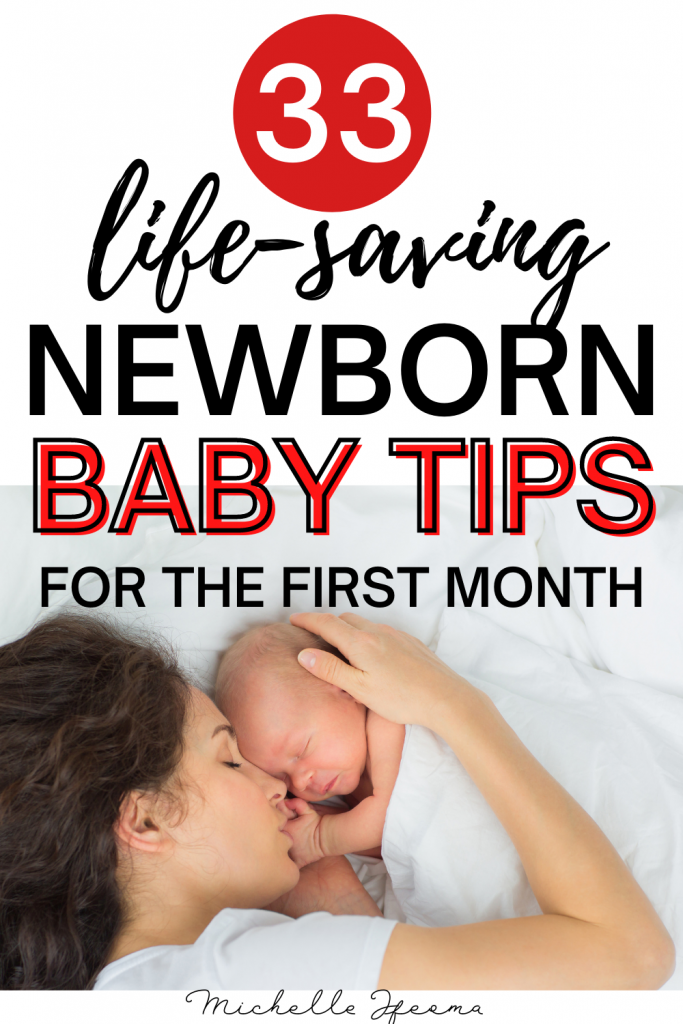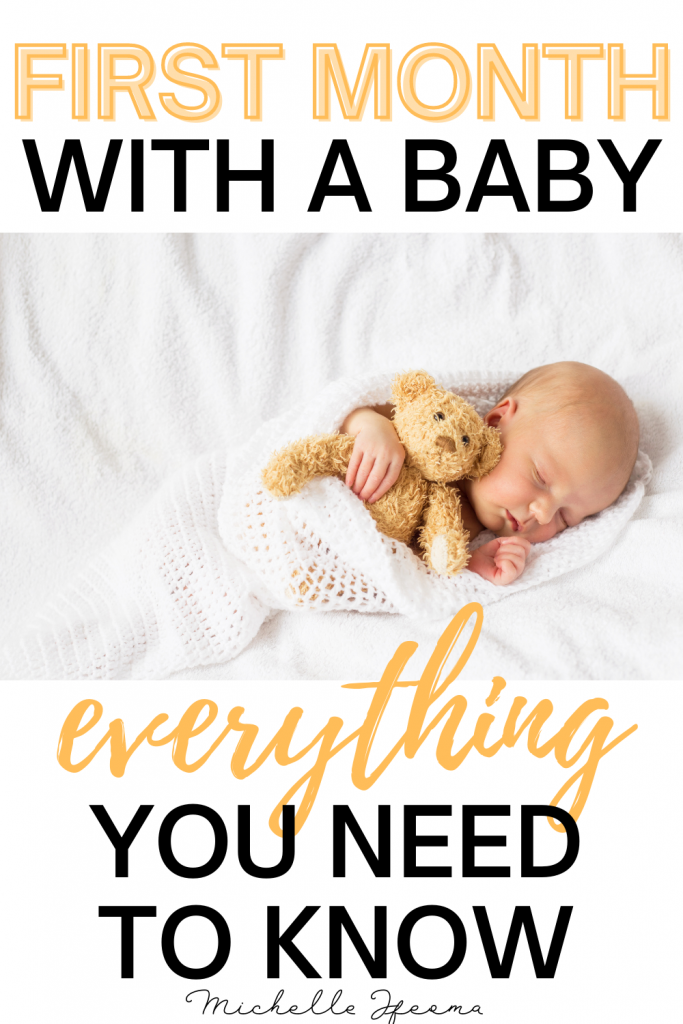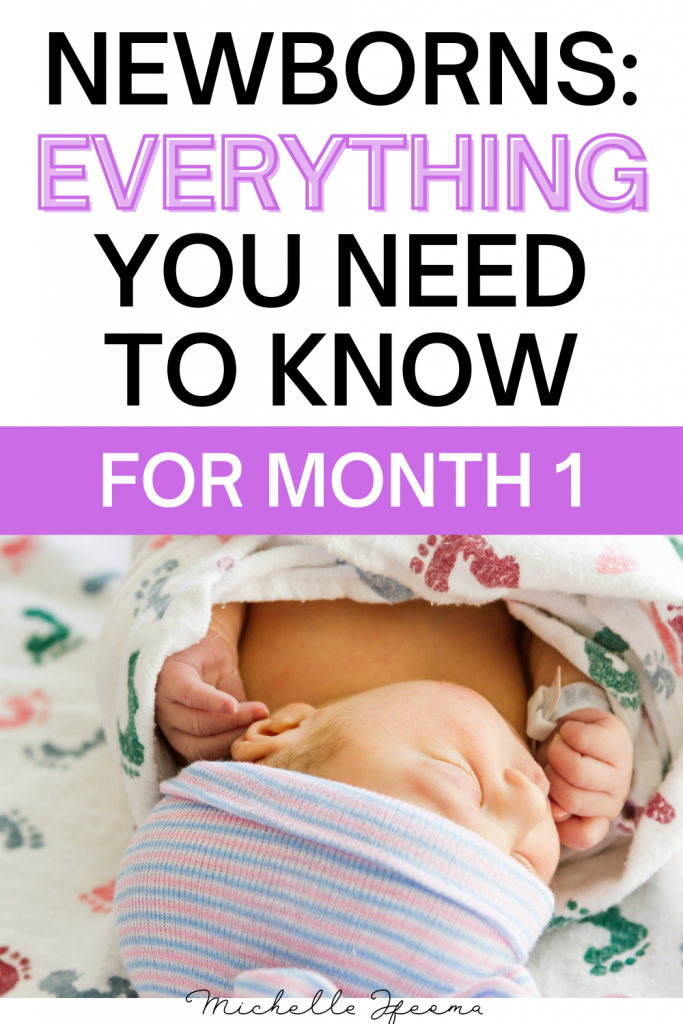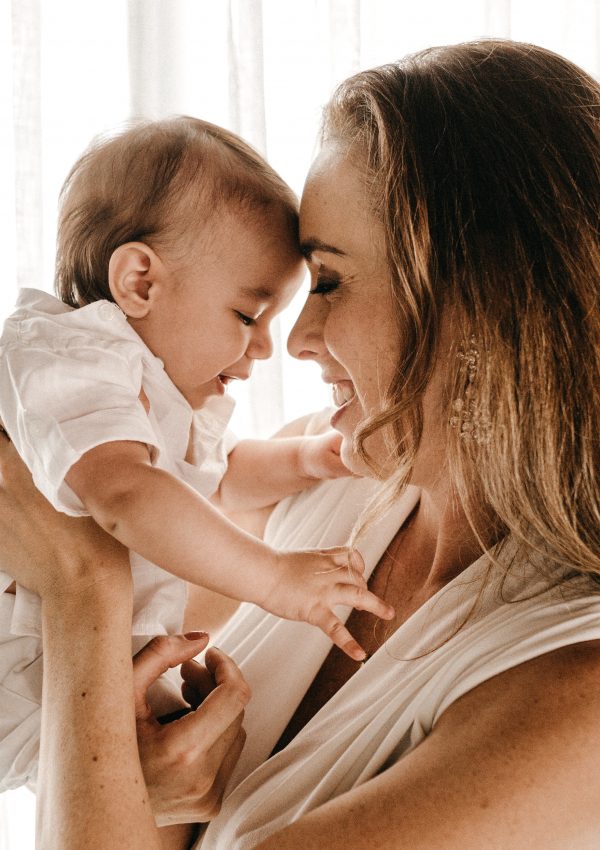Are you having a baby soon and feeling completely lost on how to care for a newborn? Here is everything you need to know about newborn baby care from feeding to sleep, and more!
This post may contain affiliate links, which means I’ll receive a commission if you purchase through my links, at no extra cost to you. Please read full disclaimer for more information.
If you’re pregnant with your first baby, coming to the realization that you’ll be caring for another life can be a little bit scary! It’s also the most exciting experience in the world.
Being a mother (or father) will stretch you to your limits and it will also be the most unforgettable time in your life. Maybe this is your first baby, or maybe it’s not and you’re looking for some tips this time around.
When I was pregnant with my first, the one thing I was really looking for was everything I needed to know about newborn baby care. I couldn’t find just one article or post that had everything I needed to know about nursing, how many diapers I should I expect, how often do babies sleep, the list goes on.
I hope that this post will give you that knowledge and also serve as the ultimate survival guide! Here’s everything you need to know about newborn baby care in the first month after giving birth.

This post is all about newborn baby care and how to get through your first month as a new parent.
What you need to know about the first month in general
You are going to be tired and it’s going to be hard.
There are going to be times where the baby will not stop crying and you won’t know what to do. There will be other times where you’re too tired to even take a shower.
You have to take it day by day and remember that it does get easier. Every day that goes by is one more day of experience and one day closer to dropping those middle of the night feeds!
Accept help when it’s offered and try to enjoy every moment you have with your newborn. This is the only time of their lives when they will need you this much. So when you’re exhausted and breastfeeding at 3AM, remember that this first month will fly by and give your baby many snuggles and kisses.
There’s so much to learn about newborn baby care when you first become a parent. But the key is to focus on the big picture. For example, the priority at this point is making sure your baby is fed. So don’t beat yourself up if you only managed to get in 5 minutes of tummy time one day instead of 10.
Remember that you are the best mother or father for your baby and you are doing great. Hang in there!
The Newborn Baby Care Ultimate 4-Week Survival Guide
Download a baby tracker app
One thing that saved my sanity in the first month was downloading a baby tracker app. No, it’s not to track your baby’s whereabouts, but to track things like feedings, diapers, and sleep.
Having this info jotted down somewhere is better than having to remember everything. It’s also smart so that you have it readily available in case the pediatrician asks. In addition, it’s on your phone, which is the one thing you take everywhere!
There are so many things you can track in this app and they’re not all important. However, it’s a good idea to track feedings and diapers at least for the first month. Doing so is a great way to see if your baby is getting enough to eat.
The best baby tracking apps:
Do skin-to-skin as often as you can
Babies love skin to skin contact with both mom and dad. After you give birth, you may have what is called the “golden hour” where you do plenty of skin-to-skin with your baby. There are countless benefits to skin-to-skin so it’s important to keep it up as often as you can within that first month.
Some easy ways to do skin-to-skin are by breastfeeding, carrying the baby in a carrier or wrap, or laying down with the baby (in just a diaper) on your bare chest. This process helps newborns self regulate and adjust to life outside of the womb.
The best carriers and wraps:
- Happy Baby Carriers – I own two of these and they’re so comfy for both you and baby! They are also suitable for babies of all ages.
- Sakura Bloom – Similar slings and carriers to Happy Baby but follow the more traditional Japanese style of baby wearing.
- Lalabu – They have these incredible Soothe Shirts that are perfect for newborns and cheaper than the prior two options!
Holding your baby often is a good thing
This tip sort of goes hand-in-hand with the first one. It’s no secret that babies love being held. You may have also heard from relatives that you can spoil your baby by holding them too much but the science says otherwise.
You can’t EVER spoil a newborn baby by holding them. Like skin-to-skin, they actually need the sensation of touching for brain development. So when they cry and just want to be held, don’t hesitate to pick them up! The fancy bassinets like the Snoo are designed to soothe your baby to sleep, but, sometimes all your baby wants is you.
Babies have an overwhelming need to suck
Babies are born with a natural sucking reflex. If you’re breastfeeding, you’ll need to understand this because it’s important to be able to tell the difference between when they’re eating or sucking for comfort. When they are eating, typically you can hear them swallowing.
Pacifiers are extremely useful for satisfying their need to suck. If you know your baby has had a full feeding but he or she still seems fussy, you might want to try a pacifier. There may be differing opinions on pacifier use but they can be used right after birth in most cases and can even decrease the risk of SIDS.
Best pacifiers for newborns:

Your baby will sleep a lot
In the first month, newborns typically sleep a lot. On average, they generally sleep for 14-17 hours a day and can really only stay awake for 30 to 45 minutes at a time.
For the first two weeks especially, it may seem like all your baby does it eat, poop, and sleep and that’s how it should be. They need a lot of sleep for brain development. By weeks 3 and 4 you’ll start to notice that your baby can stay awake for a little bit longer.
Keep it as light as possible during the day and as dark as possible at night
Your newborn might have his her or days and nights confused and that’s totally normal, since they haven’t developed a normal sleep cycle. One way you can help them adjust to days and nights is by keeping it as light as possible during the day and as dark as possible at night.
This includes keeping it as light as possible for daytime naps. You want them to be able to tell the difference between sleep during the day and sleep at night.
Sleep during the day also includes some wake time afterwards. At night, you put them right back to sleep after eating. These small changes can help them establish a normal sleep cycle faster.
Cap naps at 2 hours during the day
You don’t want long stretches of sleep during the day, you want them at night. The best way you can ensure this happens is by limiting day time naps to 2 hours. By doing this, you can also get more feedings in during the day, which means more calories consumed during the day and less calories consumed at night.
Swaddling is beneficial for newborns
The swaddle is very comforting and calming for newborns. When swaddled correctly, there are numerous benefits for your baby. To list a few, it protects the baby against their startle reflex and keeps them on their back during sleep, which lowers the risk of SIDS. It also helps them sleep longer and better.
If you don’t know how to properly swaddle a baby, you don’t have to do it the traditional way. There are plenty of easy velcro swaddles that have the same effect, and take less time!
The pacifier and swaddle combo is life-changing
Pacifier use and swaddling your baby are two of the best ways you can encourage restful sleep with a newborn. Like I mentioned above, pacifiers can soothe their need to suck (after having a full feeding of course). Swaddling will also give them that same calming feeling of being in the womb.
Some babies may also like to be swaddled while feeding and some babies may not like it so much. You kind of have to experiment to see what works best for your little one.
Place your baby to sleep on his or her back
If there’s one thing I worried about constantly as a new mom it was SIDS. I wanted to do everything I could to lower the risk of SIDS and one way you can do so is by putting your baby on his or her back for sleep. In the first month, they are too young to roll over, so you don’t have to worry about them flipping onto their bellies.
It’s also important to not put anything else in the crib or bassinet besides a fitted sheet until 1 years old. Aim to practice safe sleeping habits at all costs! It’ll really pay off in the long run.
Get a white noise machine
Newborns are loud sleepers. They are also light sleepers.
A great product that will help drown out the noise around your newborn is a white noise machine. We have been using our Hatch Sound Machine since day one and it’s been a life-saver! The sound of white noise will help calm your baby, which helps them get more restful sleep.
The best white noise machine
Babies have small stomachs
Newborn bellies are small and can only hold around 1 to 3oz of breastmilk or formula. So if it seems like your baby is eating often a) that’s a good thing and b) it’s because their stomachs can only hold so much. As your baby gets older, his or her stomach will also grow. Eventually their stomachs will be able to hold more breastmilk or formula and thus, they will be able to sleep longer stretches.
You will be feeding your baby often
It’s normal for your newborn to eat every 1 to 3 hours in the first month, which averages to about 8 to 12 times a day. It’s important to stay on top of these feedings, especially if you’re breastfeeding, in order to establish a good supply. If you are giving formula, you will want to offer 1 to 3oz at least every 3 hours to make sure your baby is getting enough to eat.
It might take your baby a while to eat
If you are breastfeeding, it’s normal for nursing sessions to take around 45 minutes in the first month. Your baby is learning how to remove milk from the breast and can take time for them to get efficient at doing so. If you give them all the time they need now, those sessions will likely drop down to 20 minutes by the second month.
If you are bottle feeding breastmilk or formula, try paced bottle feeding. Paced bottle feeding is basically when you hold the bottle more horizontal instead of vertical to give your baby more control of the milk flow. When you pace the feeds, they swallow less air and are in turn less gassy, and spit up less.
Burp your baby often
Burping your baby often can ease any discomfort he or she has from digesting breastmilk or formula. Excess gas can keep your baby from restful sleep or even prevent him or her from getting a full feed.
The best way to burp often during a nursing session is to do so after your baby is done nursing on one breast, and before you offer the other. With bottle feeding, you’ll want to burp your baby after every ounce they drink.
Bottle warmers aren’t a waste of money
Yes, there are plenty of alternatives when it comes to warming breastmilk. But speaking from experience, nothing is faster than just popping the bottle in the warmer and pressing a button. When your baby is awake crying at 3AM, you’ll want to him or her the bottle ASAP. I really feel like the best way to do it is by getting a great warmer, since you can’t microwave breastmilk.
Best bottle warmers:
Breastmilk has two main components
Breastmilk is made up of foremilk and hindmilk. Foremilk is the milk that your baby will get first when you start nursing. It has higher water content and may look clearer. Hindmilk is the fattier milk that will keep your baby fuller, longer. It’s important that your baby gets both per feeding!
Allow your baby to fully drain one breast before offering the other
Giving your baby time to fully drain one breast before offering the other is the best way to ensure that they are getting that rich hindmilk. The way I did this in the first month was by giving my baby at least 15 minutes per side. If your baby seems satisfied from just one breast, that’s fine, but always offer the other breast just in case.
If you’re breastfeeding, the haaka is a must-have
In that first month, it may feel like all you do is nurse and change diapers. You’re probably also thinking of a way to start building that freezer stash without having to use an electric pump.
The haaka is the way to do that, trust me on this.
All you do is put it on one breast, while you nurse on the other. I would use it for most sessions and collect 1 to 5oz per feed. It’s the absolute best way to have stored milk without the hassle of using an electric pump. It’s also incredibly easy to clean.
GET THE INCREDIBLE HAAKA PUMP HERE!
Encourage your baby to take full feeds
In newborn baby care, one thing you can do to lengthen those 20-minute cat naps is by encouraging your baby to take full feeds. Here’s how you can do:
- Nurse for at least 30 minutes- As your baby is learning how to nurse efficiently, they will need more time in the beginning to eat. This will also give them time to get the fatty hindmilk, which will keep them full longer.
- Keep your baby awake- Newborns often fall asleep while eating. In order to keep them awake try tickling their feet, taking off some of their clothes, stroking their face, nursing in a bright room, gently blowing in his or her face, or switching breasts.
- Check your latch- It shouldn’t hurt when you’re nursing. The best way you can ensure that you have a good latch is by seeing a lactation consultant.
Spit-up is normal
Spit-up is common in most healthy babies and they typically grow out of it around 1. It’s usually not as much as it looks when it happens, and there are a few things you can look for to make sure it’s not actual vomit:
- No fever
- Baby seems like their usual self afterwards
- It doesn’t projectile or look forceful
- Baby is still gaining weight on track
- Stools and wet diapers are normal
If you’re ever concerned about the amount of spit-up, trust your gut and contact the pediatrician. Better to have it be nothing, than to not do anything and have it be something more serious.
The easiest way to lessen spit-up in newborn baby care is by keeping your baby upright after a feed. This is where the eat, wake, sleep cycle comes in. During that wake period you can keep them upright for a few minutes before laying them down.
Prepare for cluster feeding
Cluster feeding is when your baby wants to nurse often in a certain time period. For instance, a few times an hour or every 10ish minutes. This is typically a sign of a growth spurt or a developmental leap and is completely normal. For my daughter, it usually happened in the evenings but the timing can vary from baby to baby. If you notice that you just fed your baby, but they’re still rooting or seem unsatisfied, it might be cluster feeding.
Look for early signs of hunger
You should always feed your baby when they’re showing early signs of hunger. By the time they start crying, that’s typically a late sign of hunger. It’s more difficult at that point to calm him or her down to eat. Common early cues of hunger are these:
- Smacking lips or sucking sounds
- Opening and closing mouth
- Sucking on anything nearby like their hands
In newborn baby care, you’ll always want to feed your baby when he or she is hungry and not rely so much on feeding on a schedule.

Think “eat, wake, sleep”
Since newborns only stay awake for a short amount of time, there’s only so much you can do before they’re ready to go back to sleep. Instead of trying to follow a set schedule, you’ll want to focus more on the “eat, wake, sleep” cycle. If you’ve gone through the cycle but the baby still seems restless and fussy, try starting the cycle over. You may have to go through it a couple times before it works.
Keep track of wet and dirty diapers
Keeping track of wet and dirty diapers is the easiest way to see if your baby is getting enough to eat. When your baby is born, you shouldn’t expect too many dirty diapers right off the bat. But as the first week goes on, the amount of pee and poop diapers will increase.
Also, your newborn’s poop will be black and sticky in the first couple days after birth. It’s called meconium and is made up of what they’ve ingested through the placenta. Once you are home from the hospital you’ll see their stools start to transition into a yellow or brown color.
Here is what you should expect in the first month. You want at least this many wet and dirty diapers per day:
- Delivery day: 1 black tarry stool and 1 wet diaper
- Day 1: 2 black tarry stools and 1 wet diaper
- Day 2: 3 black/brown stools and 2 wet diapers
- Day 3: 3 green stools and 3 wet diapers
- Day 4: 3 yellow stools and 4 wet diapers
- Day 5: 3 yellow stools and 5 wet diapers
- Day 6 and onwards: 3 yellow stools and 6 wet diapers
Now, some babies poop more than this and some babies poop less. If your baby’s pediatrician isn’t concerned than there is nothing to worry about. This is just to show you generally what to expect in the first month of newborn baby care.
I highly recommend tracking diapers through the whole first month of newborn baby care. If there’s ever anything wrong, your pediatrician will probably ask 1) how much food the baby is getting and 2) how many wet and dirty diapers are there per day. You want to make sure you have that info if need be.
Healthy stools in a newborn
- Breastfed babies typically have loose, and yellow-seedy stools that look like mustard.
- Formula fed babies typically have yellow or brown, peanut butter-like stools. They also might smell more than a breastfed baby’s stools
Tip: Get diapers with a wetness indicator line!
Umbilical cord care
In newborn baby care, one thing you do have to be gentle with is your baby’s umbilical cord. It usually dries up and falls out 1 to 2 weeks after birth. During this time frame it’s advised that you stick to sponge baths.
Sponge baths will help prevent the umbilical cord from being submerged in water, which can cause infection. It’s important not to put anything on it besides the mild bath soap and water from the sponge bath. Otherwise, it’s advised to keep it as dry as possible and leave it alone. I always folded the diaper down below the cord stump as well to prevent any irriation.
Once the cord falls off, resume sponge baths for a few more days. After that, then it’s fine to begin tub baths, if their belly button is dried and healed.
When to call the pediatrician:
- You notice your baby’s belly button smells
- Discharge coming from the belly button/cord area
- Redness or irritation around the cord
- Your baby seems to be in pain when you touch it
You can begin regular baths when the umbilical cord falls out
Baths are a great way to bond with your baby and help soothe them. It’s also a great step to incorporate into a bedtime routine. Even though they may hate them at first, they will learn to love baths eventually! Here are some great bath tips to keep in mind:
- Use a hypoallergenic and tear-free baby wash (usually they’re 2-in-1 washes and shampoos)
- To test the warmth of the bath water, use your elbow and not your hands
- Only use a damp wash cloth (with no soap) to clean your baby’s face
- Always follow-up with a moisturizing baby lotion
- Get a good baby bath tub that they can use for a while
- Babies don’t need any fancy products, my baby has curly hair so I just put baby oil on her hair after a bath. That’s it!
Calming your baby
When your baby is wailing, you may be panicking trying to figure out what to do. Good news is, for most babies, there are quite a few simple solutions you can try in newborn baby care:
- “Eat, wake, sleep”
- Feed the baby at the earliest signs of hunger
- Encourage a full feed
- Breastfeeding
- Skin-to skin
- Rocking
- Pacifier
- Swaddle
- White noise
If none of these work, contacting the pediatrician may be a good idea so you can rule out colic, tongue-tie, or any other medical conditions.
No 2 days are the same
Although sample schedules are incredibly helpful, you can’t expect a newborn to follow a set schedule. They pretty much eat when they want and sleep when they want. No two days are the same! You just have to take it one day at a time until roughly the 2 month mark, where you can possibly have some semblance of a schedule.
Walking is a great way to exercise and get fresh air with your baby

Going outside and getting fresh air is great for babies and mom. Be sure to dress the baby appropriately when you leave the house and keep them out of direct sunlight. Their skin is very sensitive and sunscreen use isn’t advised until 6 months. During the summer, I would time walks with my baby in the early morning or evening when the sun wasn’t as intense.
The rocking motion of the stroller is also great for helping them sleep!
Fun ways to play with your baby
Once you factor in feeding and a diaper change, your newborn is probably drowsy. But nonetheless, you can still play with the little time that you do have. Here are some simple ways you can play with your little one:
- Tummy time- There are so many benefits to tummy time and you can start as soon as you bring your baby home. Doing it on the floor or mat may be to much for them so you can try it different ways:
- On your stomach
- On your knees
- On the playmat using a prop like a nursing pillow
You’ll want to strive for 10 minutes of tummy time a day in the first month.
- Talking- You can simply describe to your little one what you’re doing or talk about how your day went
- Singing– You don’t have to be the best singer! Your baby will love it because it’s you. It also helps them develop their language skills
- Reading– It’s never too early to start reading to your baby. It’s great for bonding and is yet another way to help them to develop their language skills!
There are roughly 3 growth spurts in the first month alone
It’s no secret that babies grow incredibly fast. But during the first month, there are usually 3 to 4 growth spurts (depending on how close your baby was born to their due date):
- A few days after you return home from the hospital
- 7-10 days after birth
- 2-3 weeks after birth
- 4-6 weeks after birth
All babies grow at different speeds, so this may or may not be the case for your little one. During this time, your baby may also be exhibiting different behaviors:
- Wanting to eat more (cluster feeding)
- Sleeping more (or less)
- May seem fussier
Growth spurts typically pass within a few days. So it’s definitely a good idea to keep some baby clothes on hand in different sizes!
Lastly, you’ll probably have 3 well visits with the pediatrician
In the first month, you will likely have 3 well visits with the pediatrician:
- One just a few days after birth
- The second one around 2 weeks after birth (which is usually just a weight check)
- Then the third one at 1 month
They are all the same, more or less. The main difference is the type of recommended vaccines your baby might be getting. The usual routine is that they take your baby’s weight, height, and head circumference. Then they will go over any questions that you have, as well as some of the milestones to begin working toward.
The doctor will also ask you plenty of questions about how much your baby is eating, how many wet and dirty diapers he or she has per day, how much the baby sleeps, and so forth. It’s important to have all of this information at hand, which is why I recommended using a baby tracker app.
Free Printables
Below are a few sample schedules to help give you an idea of what to expect in the first month with a newborn. There’s a really small chance that your baby will follow these schedules to a tee.
Newborns can nap anywhere from 10 minutes to 4 hours so the key is to ensure that you’re getting that minimum of 8 feedings in. Realistically, you can expect your newborn to nap 4-8 times during the day and wake up multiple times at night.
Remember to look for those early hunger cues and keep an eye on wet and dirty diapers! Good luck mama!
Weeks 1 and 2
Your baby will sleep a lot in the first two weeks and only stay awake for what seems like a few minutes. You’ll also want to keep an eye on those wet and dirty diapers to ensure that he or she is eating enough.
Between weeks 1 and 2 there will likely be a growth spurt also. Be prepared for cluster feedings!
Weeks 3 and 4
Not much will change in the second half of the month. You’ll want to ensure that your baby still has at least 6 wet diapers and 3 dirty diapers every day and try to get some more tummy time in! Wake times are generally still around 45 minutes.
There’s also another growth spurt during this time so be on the lookout for an extra hungry baby and more cluster feeding.
This post showed you everything you need to know about newborn baby care.





